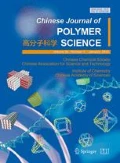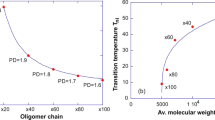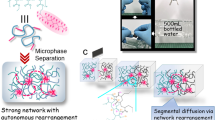Abstract
Elastomeric vitrimers with covalent adaptable networks are promising candidates to overcome the intrinsic drawbacks of conventional covalently-crosslinked elastomers; however, most elastomeric vitrimers show poor mechanical properties and require the addition of exogenous catalysts. Herein, we fabricate a catalyst-free and mechanically robust elastomeric vitrimer by constructing a segregated structure of sodium alginate (SA) in the continuous matrix of epoxidized natural rubber (ENR), and further crosslinking the composite by exchangeable hydroxyl ester bonds at the ENR-SA interfaces. The manufacturing process of the elastomeric vitrimer is facile and environmentally friendly without hazardous solvents or exogenous catalysts, as the abundant hydroxyl groups of the segregated SA phase can act as catalyst to activate the crosslinking reaction and promote the dynamic transesterification reaction. Interestingly, the segregated SA structure bears most of the load owing to its high modulus and small deformability, and thus ruptures preferentially upon deformation, leading to efficient energy dissipation. Moreover, the periodic stiffness fluctuation between rigid segregated SA phase and soft ENR matrix is beneficial to the crack-resisting. As a result, the elastomeric vitrimer manifests exceptional combination of catalyst-free, defect-tolerance, high tensile strength and toughness. In addition, the elastomeric vitrimer also exhibits multi-shape memory behavior which may further broaden its applications.
Similar content being viewed by others
References
Guo, B.; Tang, Z.; Zhang, L. Transport performance in novel elastomer nanocomposites: mechanism, design and control. Prog. Polym. Sci. 2016, 61, 29–66.
Li, H.; Yang, L.; Weng, G.; Xing, W.; Wu, J.; Huang, G. Toughening rubbers with a hybrid filler network of graphene and carbon nanotubes. J. Mater. Chem. A 2015, 3, 22385–22392.
Wei, T.; Lei, L.; Kang, H.; Qiao, B.; Wang, Z.; Zhang, L.; Coates, P.; Hua, K. C.; Kulig, J. Tough bio-based elastomer nanocomposites with high performance for engineering applications. Adv. Eng. Mater. 2012, 14, 112–118.
Deng, F.; Ito, M.; Noguchi, T.; Wang, L.; Ueki, H.; Niihara, K. I.; Kim, Y. A.; Endo, M.; Zheng, Q. S. Elucidation of the reinforcing mechanism in carbon nanotube/rubber nanocomposites. ACS Nano 2011, 5, 3858–3866.
Cianchetti, M.; Laschi, C.; Menciassi, A.; Dario, P. Biomedical applications of soft robotics. Nat. Rev. Mater. 2018, 3, 143–153.
Denissen, W.; Winne, J. M.; Du Prez, F. E. Vitrimers: permanent organic networks with glass-like fluidity. Chem. Sci. 2016, 7, 30–38.
Montarnal, D.; Capelot, M.; Tournilhac, F.; Leibler, L. Silka-like malleable materials from permanent organic networks. Science 2011, 334, 965.
Krishnakumar, B.; Sanka, R. V. S. P.; Binder, W. H.; Parthasarthy, V.; Rana, S.; Karak, N. Vitrimers: associative dynamic covalent adaptive networks in thermoset polymers. Chem. Eng. J. 2020, 385, 123820.
Ling, F.; Liu, Z.; Chen, M.; Wang, H.; Zhu, Y.; Ma, C.; Wu, J.; Huang, G. Compatibility driven self-strengthening during the radical-responsive remolding process of poly-isoprene vitrimers. J. Mater. Chem. A 2019, 7, 25324–25332.
Capelot, M.; Montarnal, D.; Tournilhac, F.; Leibler, L. Metal-catalyzed transesterification for healing and assembling of thermosets. J. Am. Chem. Soc. 2012, 134, 7664–7667.
Saed, M. O.; Gablier, A.; Terentejv, E. M. Liquid crystalline vitrimers with full or partial boronic-ester bond exchange. Adv. Funct. Mater. 2019, 1906458.
Cromwell, O. R.; Chung, J.; Guan, Z. Malleable and self-healing covalent polymer networks through tunable dynamic boronic ester bonds. J. Am. Chem. Soc. 2015, 137, 6492–6495.
Obadia, M. M.; Mudraboyina, B. P.; Serghei, A.; Montarnal, D.; Drockenmuller, E. Reprocessing and recycling of highly cross-linked ion-conducting networks through transalkylation exchanges of C-N bonds. J. Am. Chem. Soc. 2015, 137, 6078–6083.
Hendriks, B.; Waelkens, J.; Winne, J. M.; Du Prez, F. E. Poly(thioether) vitrimers via transalkylation of trialkylsulfonium salts. ACS Macro Lett. 2017, 6, 930–934.
Rottger, M.; Domenech, T.; van der Weegen, R.; Breuillac, A.; Nicolay, R.; Leibler, L. High-performance vitrimers from commodity thermoplastics through dioxaborolane metathesis. Science 2017, 356, 62.
Breuillac, A.; Kassalias, A.; Nicolay, R. Polybutadiene vitrimers based on dioxaborolane chemistry and dual networks with static and dynamic cross-links. Macromolecules 2019, 52, 7102–7113.
Taynton, P.; Ni, H.; Zhu, C.; Yu, K.; Loob, S.; Jin, Y.; Qi, H. J.; Zhang, W. Repairable woven carbon fiber composites with full recyclability enabled by malleable polyimine networks. Adv. Mater. 2016, 28, 2904–2909.
Taynton, P.; Yu, K.; Shoemaker, R. K.; Jin, Y.; Qi, H. J.; Zhang, W. Heat- or water-driven malleability in a highly recyclable covalent network polymer. Adv. Mater. 2014, 26, 3938–3942.
Lu, Y. X.; Tournilhac, F.; Leibler, L.; Guan, Z. Making insoluble polymer networks malleable via olefin metathesis. J. Am. Chem. Soc. 2012, 134, 8424–8427.
Cao, L.; Fan, J.; Huang, J.; Chen, Y. A robust and stretchable cross-linked rubber network with recyclable and self-healable capabilities based on dynamic covalent bonds. J. Mater. Chem. A 2019, 7, 4922–4933.
Zhang, H.; Cai, C.; Liu, W.; Li, D.; Zhang, J.; Zhao, N.; Xu, J. Recyclable polydimethylsiloxane network crosslinked by dynamic transesterification reaction. Sci. Rep. 2017, 7, 11833.
Zhang, G.; Zhou, X.; Liang, K.; Guo, B.; Li, X.; Wang, Z.; Zhang, L. Mechanically robust and recyclable EPDM rubber composites by a green cross-linking strategy. ACS Sustain. Chem. Eng. 2019, 7, 11712–11720.
Argyle, M.; Bartholomew, C. Heterogeneous catalyst deactivation and regeneration: a review. Catalysts 2015, 5, 145–269.
Brutman, J. P.; Delgado, P. A.; Hillmyer, M. A. Polylactide vitrimers. ACS Macro Lett. 2014, 3, 607–610.
Capelot, M.; Unterlass, M. M.; Tournilhac, F.; Leibler, L. Catalytic control of the vitrimer glass transition. ACS Macro Lett. 2012, 1, 789–792.
Legrand, A.; Soulié-Ziakovic, C. Silica-epoxy vitrimer nanocomposites. Macromolecules 2016, 49, 5893–5902.
Yu, K.; Shi, Q.; Dunn, M.; Wang, T.; Qi, H. Carbon fiber reinforced thermoset composite with near 100% recyclability. Adv. Funct. Mater. 2016, 26, 6098–6106.
Spiesschaert, Y.; Guerre, M.; Imbernon, L.; Winne, J. M.; Du Prez, F. Filler reinforced polydimethylsiloxane-based vitrimers. Polymer 2019, 172, 239–246.
Wu, S.; Yang, Z.; Fang, S.; Tang, Z.; Liu, F.; Guo, B. Malleable organic/inorganic thermosetting hybrids enabled by exchangeable silyl ether interfaces. J. Mater. Chem. A 2019, 7, 1459–1467.
Tang, Z.; Liu, Y.; Guo, B.; Zhang, L. Malleable, mechanically strong, and adaptive elastomers enabled by interfacial exchangeable bonds. Macromolecules 2017, 50, 7584–7592.
Liu, Y.; Tang, Z.; Chen, Y.; Zhang, C.; Guo, B. Engineering of β-hydroxyl esters into elastomer-nanoparticle interface toward malleable, robust, and reprocessable vitrimer composites. ACS Appl. Mater. Interfaces 2018, 10, 2992–3001.
Han, J.; Liu, T.; Hao, C.; Zhang, S.; Guo, B.; Zhang, J. A catalyst-free epoxy vitrimer system based on multifunctional hyperbranched polymer. Macromolecules 2018, 51, 6789–6799.
Qiu, M.; Wu, S.; Tang, Z.; Guo, B. Exchangeable interfacial crosslinks towards mechanically robust elastomer/carbon nanotubes vitrimers. Compos. Sci. Technol. 2018, 165, 24–30.
Qiu, M.; Wu, S.; Fang, S.; Tang, Z.; Guo, B. Sustainable, recyclable and robust elastomers enabled by exchangeable interfacial cross-linking. J. Mater. Chem. A 2018, 6, 13607–13612.
Liu, W.; Schmidt, D.; Reynaud, E. Catalyst selection, creep, and stress relaxation in high-performance epoxy vitrimers. Ind. Eng. Chem. Res. 2017, 56, 2667–2672.
Demongeot, A.; Groote, R.; Goossens, H.; Hoeks, T.; Tournilhac, F.; Leibler, L. Cross-linking of poly(butylene terephthalate) by reactive extrusion using Zn(II) epoxy-vitrimer chemistry. Macromolecules 2017, 50, 6117–6127.
Long, R.; Qi, H.; Dunn, M. Modeling the mechanics of covalently adaptable polymer networks with temperature-dependent bond exchange reactions. Soft Matter 2013, 9, 4083–4096.
Wu, J.; Cai, L.-H.; Weitz, D. A. Tough self-healing elastomers by molecular enforced integration of covalent and reversible networks. Adv. Mater. 2017, 29, 1702616.
Zhu, Y.; Shen, Q.; Wei, L.; Fu, X.; Huang, C.; Zhu, Y.; Zhao, L.; Huang, G.; Wu, J. Ultra-tough, strong, and defect-tolerant elastomers with self-healing and intelligent-responsive abilities. ACS Appl. Mater. Interfaces 2019, 11, 29373–29381.
Zhao, X. Multi-scale multi-mechanism design of tough hydrogels: building dissipation into stretchy networks. Soft Matter 2014, 10, 672–687.
Haque, M. A.; Kurokawa, T.; Kamita, G.; Gong, J. P. Lamellar bilayers as reversible sacrificial bonds to toughen hydrogel: hysteresis, self-recovery, fatigue resistance, and crack blunting. Macromolecules 2011, 44, 8916–8924.
Cui, K.; Sun, T. L.; Liang, X.; Nakajima, K.; Ye, Y. N.; Chen, L.; Kurokawa, T.; Gong, J. P. Multiscale energy dissipation mechanism in tough and self-healing hydrogels. Phys. Rev. Lett. 2018, 121, 185501.
Huang, Y.; King, D.; Cui, W.; Taolin, S.; Guo, H.; Kurokawa, T.; Brown, H.; Hui, C. Y.; Gong, J. Superior fracture resistance of fiber reinforced polyampholyte hydrogels achieved by extraordinarily large energy-dissipative process zones. J. Mater. Chem. A 2019, 13431–13440.
Egan, P.; Sinko, R.; Leduc, P.; Keten, S. The role of mechanics in biological and bio-inspired systems. Nat. Commun. 2015, 6, 7418.
Peterlik, H.; Roschger, P.; Klaushofer, K.; Fratzl, P. From brittle to ductile fracture of bone. Nat. Mater. 2006, 5, 52–55.
Yang, W.; Sherman, V. R.; Gludovatz, B.; Schaible, E.; Stewart, P.; Ritchie, R. O.; Meyers, M. A. On the tear resistance of skin. Nat. Commun. 2015, 6, 6649.
Aizenberg, J.; Weaver, J.; Thanawala, M.; Sundar, V.; Morse, D.; Fratzl, P. Skeleton of Euplectella sp.: structural hierarchy from the nanoscale to the macroscale. Science 2005, 309, 275–278.
Fratzl, P.; Gupta, H.; Fischer, F.; Kolednik, O. Hindered crack propagation in materials with periodically varying Young’s modulus—lessons from biological materials. Adv. Mater. 2007, 19, 2657–2661.
Beese, A. M.; An, Z.; Sarkar, S.; Nathamgari, S. S. P.; Espinosa, H. D.; Nguyen, S. T. Defect-tolerant nanocomposites through bio-inspired stiffness modulation. Adv. Funct. Mater. 2014, 24, 2883–2891.
Feng, Z.; Hu, J.; Zuo, H.; Ning, N.; Zhang, L.; Yu, B.; Tian, M. Photothermal-induced self-healable and reconfigurable shape memory bio-based elastomer with recyclable ability. ACS Appl. Mater. Interfaces 2019, 11, 1469–1479.
Yang, Z.; Wang, Q.; Wang, T. Dual-triggered and thermally reconfigurable shape memory graphene-vitrimer composites. ACS Appl. Mater. Interfaces 2016, 8, 21691–21699.
Zhang, S.; Liu, T.; Cheng, H.; Wang, L.; Han, J.; Liu, H.; Zhang, J. Preparation of a lignin-based vitrimer material and its potential use for recoverable adhesive. Green Chem. 2018, 20, 2995–3000.
Peng, Y.; Zhao, L.; Yang, C.; Yang, Y.; Song, C.; Wu, Q.; Huang, G.; Wu, J. Super tough and strong self-healing elastomers based on polyampholytes. J. Mater. Chem. A 2018, 6, 19066–19074.
Meyers, M. A.; McKittrick, J.; Chen, P. Y. Structural biological materials: critical mechanics-materials connections. Science 2013, 339, 773.
Maghsoudi-Ganjeh, M.; Lin, L.; Wang, X.; Zeng, X. Bioinspired design of hybrid composite materials. Int. J. Smart Nano Mater. 2019, 10, 90–105.
Mazinova, I.; Florian, P. Materials selection in mechanical design. 2014, p. 145–153.
Wegst, U.; Ashby, M. The mechanical efficiency of natural materials. Philosophical Magazine A-physics of Condensed Matter Structure Defects and Mechanical Properties — PHIL MAG A 2004, 84, 2167–2186.
Acknowledgments
This work was financially supported by the National Natural Science Foundation of China (Nos. 51873110 and 51790501), State Key Laboratory of Polymer Materials Engineering (No. sklpme2019-2-14), and the Fundamental Research Funds for Central Universities.
Author information
Authors and Affiliations
Corresponding author
Supporting Information
10118_2020_2479_MOESM1_ESM.pdf
An Interfacial Dynamic Crosslinking Approach toward Catalyst-free and Mechanically Robust Elastomeric Vitrimer with a Segregated Structure
Rights and permissions
About this article
Cite this article
Zhu, Y., Gao, JL., Zhang, LJ. et al. An Interfacial Dynamic Crosslinking Approach toward Catalyst-free and Mechanically Robust Elastomeric Vitrimer with a Segregated Structure. Chin J Polym Sci 39, 201–210 (2021). https://doi.org/10.1007/s10118-020-2479-6
Received:
Accepted:
Published:
Issue Date:
DOI: https://doi.org/10.1007/s10118-020-2479-6




